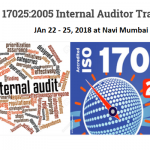Understanding and implementing P D C A – Plan – Do – Check – Act for ISO 9001, 14001, OHSAS 18001 & ohter ISO standards
The ISO 9001 model is based on a specific management philosophy. This philosophy determines the structure, planning and implementation of the standard. It is the single most important element which is embedded within the standard. It’s called the Shewhart/Deming Cycle. It is a simple but powerful concept. This cycle contains four elements:
Plan > Do > Check > Act
where as an organization,
- You plan the elements of the QMS in order to meet customer requirements and enhance their satisfaction;
- You implement the QMS as per the plan;
- You monitor, measure and analyze the performance of the QMS against the plan; and
- You take actions to continually improve the QMS.
You will also need to apply the same philosophy when managing the processes that make up the QMS, where
- You establish the objectives to be achieved for a given process and determine the necessary activities, resources and methods of operation and control to achieve those objectives;
- You implement the plan;
- You monitor, measure and analyze the performance of the process against the plan; and
- You take actions to continually improve the process.
Therefore, the PDCA philosophy is applied at both the system and process levels. And where necessary, it can also be applied further down at the activity level. This is the master key to the understanding, planning and implementation of the ISO 9001 model. This approach enables you to explore the QMS down to its very last detail.
The Shewhart/Deming approach provides you with a consistent method for the management of the QMS, both at the macro and micro levels. It is also very useful when planning the documentation of the QMS. You will have to determine the purpose of a certain documentation and the objectives it is supposed to achieve. Then implement and monitor its usage and consequently identify areas or opportunities for continual improvement.  In order to ensure the effective application of this approach, you will need to establish an effective QMS organization that thrives on communication.
For example, top management is responsible for ensuring that quality objectives are established at the relevant functions and levels of the organization. How would you go about doing this? Simply apply:
PLAN:Â What is the objective of this task?
DO:Â Define the resources and methods of achieving this task?
CHECK:Â Define how the quality objectives are to be monitored, measured and analyzed?
ACT:Â Define the improvement processes of the quality objectives?
There are various inputs to be considered at the planning stage. Top management has to be clear on the corporate objectives in order to ensure that the quality objectives are well-aligned to them.
This is an example of the Shewhart/Deming Cycle application in the Product Design process- Clause 7.3:
Plan
- 7.3.1 Design and development planning
- 7.3.2 Design and development inputs
Do
- 7.3.3 Design and development outputs
Check
- 7.3.4 Design and development review
- 7.3.5 Design and development verification
- 7.3.6 Design and development validation
Act
- 7.3.7 Design changes
Â
Â







